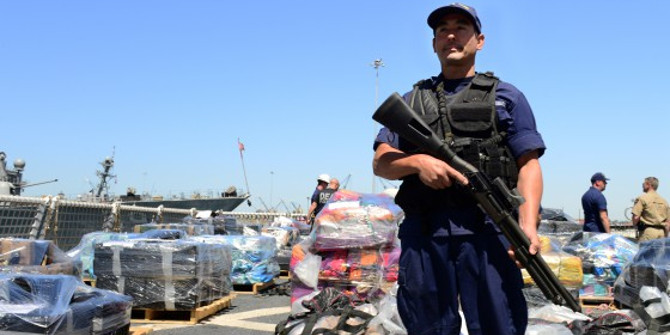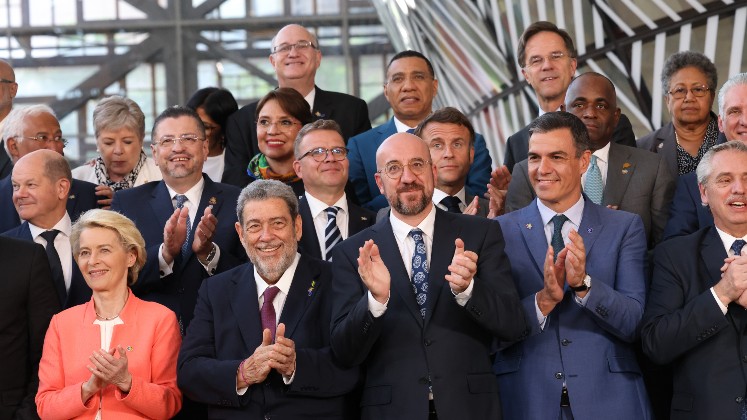The European Union remains the top investor in Latin America and the Caribbean. But the economic and diplomatic pressure from the US and China remains. The recent EU and CELAC summit showed promising new steps on climate action, digital alliance, and sustainable trade, Andrea Colombo (University of Salamanca) writes.
Many things did not sound new during the III EU-CELAC summit celebrated on July 17th and 18th in Brussels, the first bi-regional meeting in 8 years. From the official declarations of representatives referring to ‘old friends’ and a shared history to the calls for a renewal of the partnership and the need to push for a more sustainable, greener, and fairer development. “A new beginning for old friends” said Ursula von der Leyen, president of the European Commission, vouching for a fresh start between the two regions. After all, besides the concrete advancements in the modernisation of bi-regional trade deals, the Global Gateway measures and the various agreements signed during the summit, meeting and assessing each other’s credibility as reliable partners for cooperation was the real objective of these talks.
The European Union remains the top investor in Latin America and the Caribbean (LAC), bi-regional commerce increased by 40% since 2018, and various cooperation projects (EUROCLIMA+, EL PACcTO, EUROsociAL+ etc.) have been implemented. Yet, the EU’s external action in the region has been overshadowed by the penetration of China, both economically and diplomatically, and the relevance of the historical regional presence of the United States. This summit was crucial for the EU to regain relevance, establish the status of the EU as a credible ally for the region, and vice versa. There have always been doubts on both sides. On the one hand, LAC leaders rightfully criticized the EU’s swinging attention to the region, a point of self-criticism of many EU leaders as well. The European Union’s foreign policy chief, Josep Borrell, acknowledged that the EU had “taken for granted or even neglected” Latin America and the Caribbean over the last decade. On the other, the EU wanted to be reassured about the commitments of LAC countries to the UN charter, with clear referrals to the war in Ukraine.
Most LAC countries condemned the blatant Russian invasion of Ukraine in the UN General Assembly (with few exceptions), but the periodical statements on the war from some leaders, namely Brazilian president Luiz Inacio Lula da Silva, left many doubts. In the end, there was a partial compromise. Though unsatisfactory and shy, 59 out of 60 countries signed the Final Communiqué, with the exception of Nicaragua, in which “deep concern” is expressed for the war against Ukraine. Concern, but not a condemnation of the aggression, and the absence of a specific mention of “Russia” must be noted. But ultimately, the EU and LAC regions agreed to move past the war and focus on the many issues concerning the bilateral partnership. This summit was not the ideal place to deal with LAC’s shy role in condemning Russia, except for Chile’s president Gabriel Boric, since lingering too much on it would have undermined the work pending.
Besides the war in Ukraine, the summit embraced topics that reflected both sides’ demands and interests. Climate change, sustainable development and the digital alliance were predictably the most prevalent themes but they are not conflict-free terrains. The differences concerning trade and environmental clauses kept coming up during press statements. Josep Borrell said during the summit that “there will be no breakthrough on the EU-MERCOSUR deal“. Still, both parties seemed very confident about the near future of the deal.
Addressing climate change and reinvigorating relations
The final bilateral declaration also contains important points for the Caribbean, including a mention of the particular effects of climate change and the reaching of a post-Cotonou agreement, which was many years in the making. There was also a specific EU-Caribbean leaders’ meeting together with a series of bilateral encounters with Caribbean prime ministers and presidents. Part of the merits of this has surely been due to the skilful mediation of the CELAC’s pro-tempore president and Prime Minister of Saint Vincent and the Grenadines: Ralph Gonsalves. He managed to generate consensus among other LAC leaders by speaking for the region as a whole while also stressing the role of the Caribbean and its small-island states.
This summit’s main outcome is the agreement on establishing a permanent mechanism to meet every two years and the designation of Bogotá as the next host of the EU-CELAC summit in 2025. This is crucial for re-establishing close and periodical encounters between the two regions and will serve as the platform to launch concrete cooperation initiatives. The fact that meetings will be biannual and not every three or four years is also a strong sign of mutual interest. On the same note, a roadmap of bilateral meetings, both at the top political, ministerial, and civil society levels, has already been agreed upon.
The announcements related to the Global Gateway, a massive global infrastructure investment initiative of the EU, are favourable. It will represent €45 billion for Latin America and the Caribbean and will be spread among various projects following the three main priorities of climate action, digital infrastructures, and social development. Lastly, a series of important memoranda of understanding (MoU) was signed between the EU and Ecuador, Honduras, and El Salvador to advance towards the political cooperation pillar. The EU also signed another MoU with Chile, Uruguay and Argentina on clean energies and raw materials to work on climate action and establishing supply chains of critical commodities such as lithium.
After long years of ignoring each other, with responsibilities shared by both sides, the two regions met again, pushed by a global context that changed radically compared to pre-pandemic and pre-war times.
Not all demands were satisfied, and the concrete results are modest, but this meeting was a good starting point to reinvigorate the relations between regions. Although there was no breakthrough concerning the EU-MERCOSUR deal, this was a new way for partners to rebuild trust, assess common interests and make more room for cooperation. There is no denying that the EU-LAC relation has its natural limits compared to China and the US economic and diplomatic firepower in the region. Yet, in some areas, namely climate action, the digital alliance and sustainable trade, there is room for manoeuvre, and this summit in Brussels showed that the EU and CELAC states took a few (small) steps in this direction.
Notes:
• The views expressed here are of the author rather than the Centre or the LSE
• Please read our Comments Policy before commenting
• Banner image: President of Argentina, Prime Minister of Saint Vincent and the Grenadines, President of the European Council and President of the European Commission in Brussels / European Union





